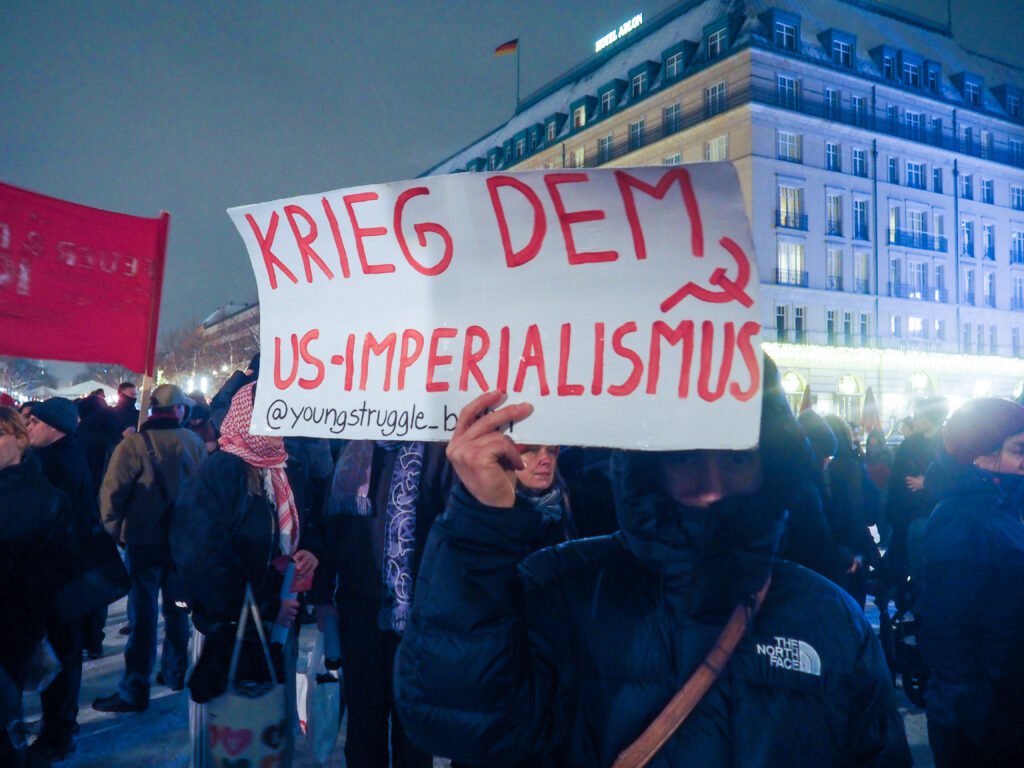
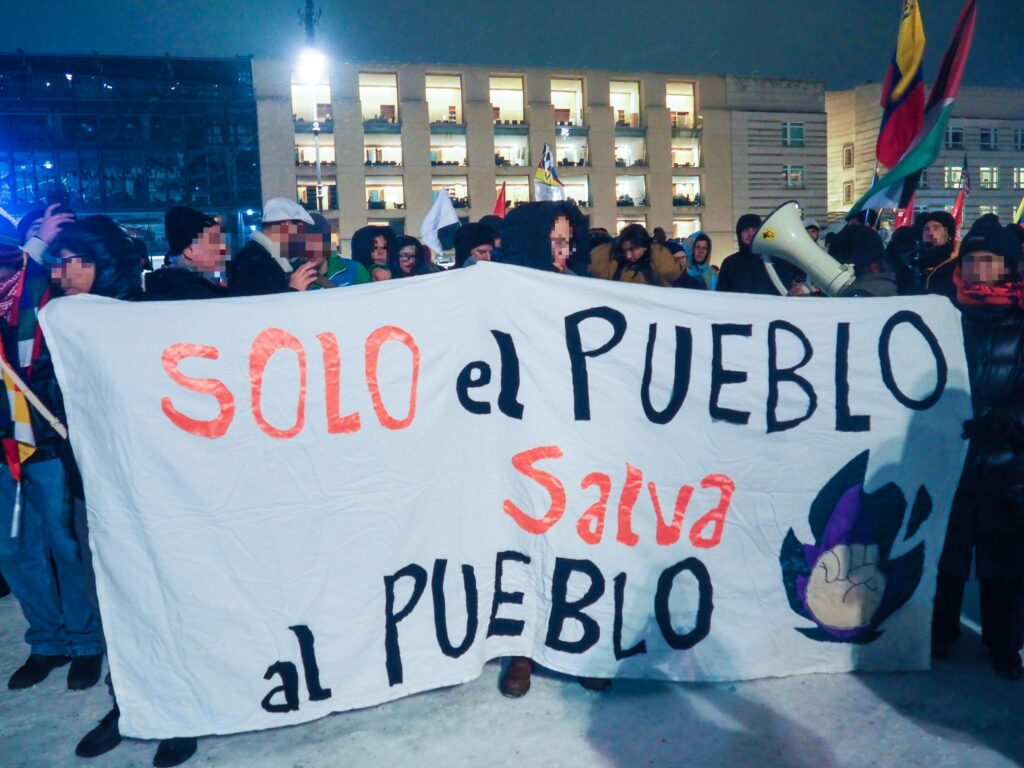

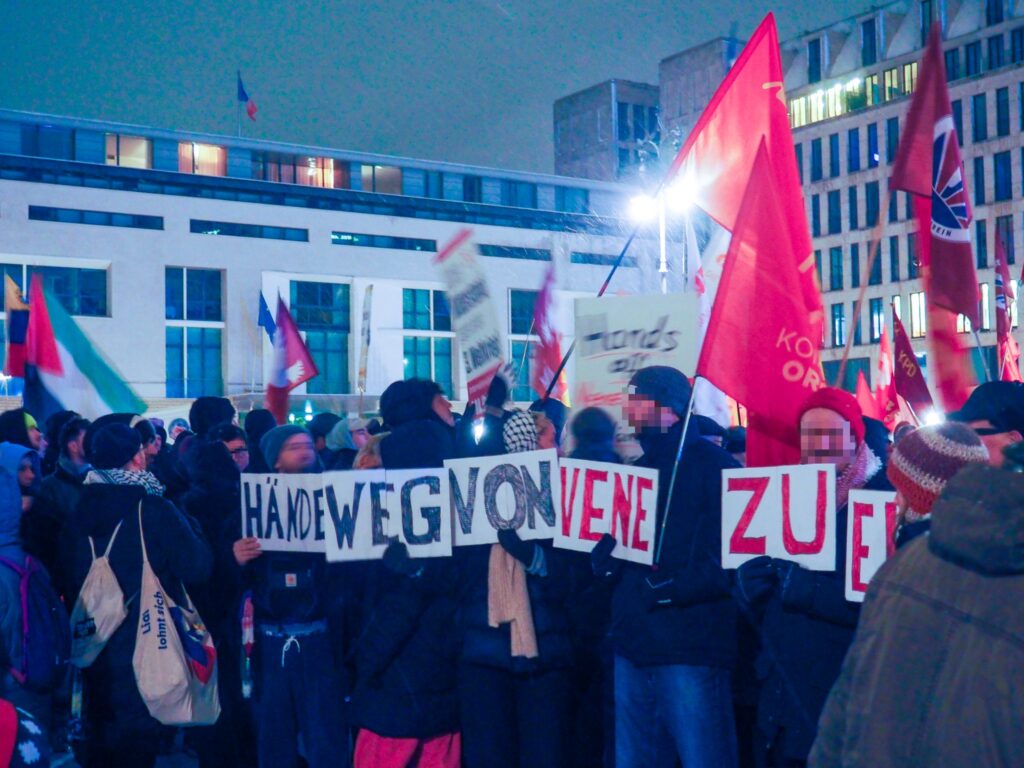






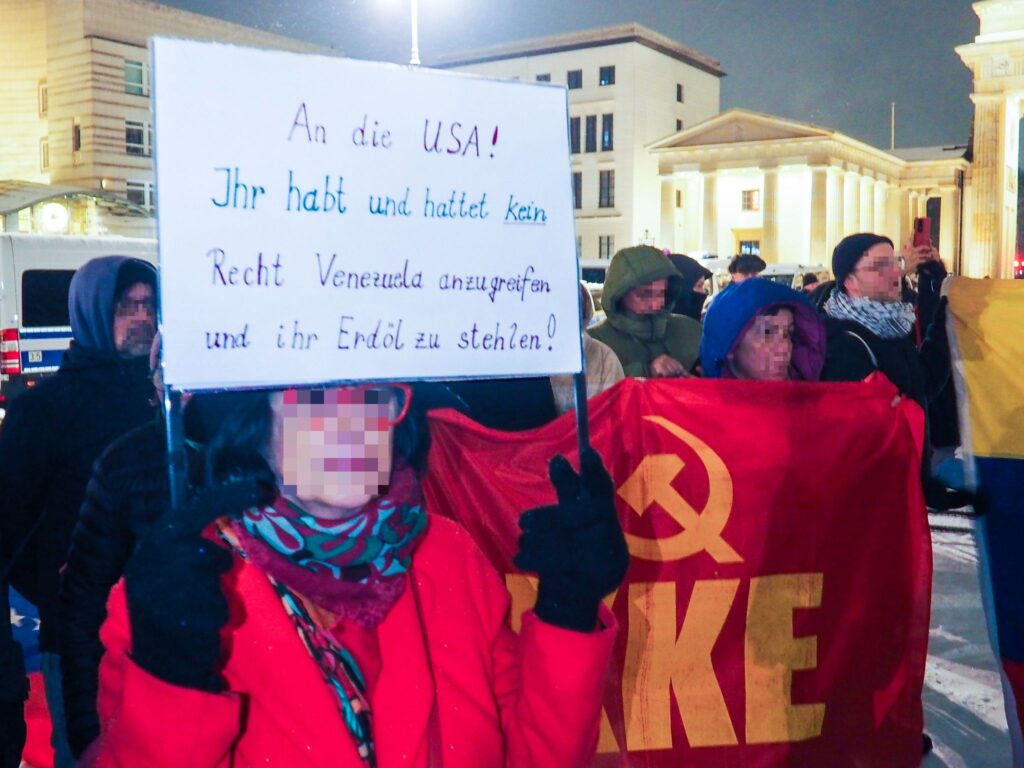
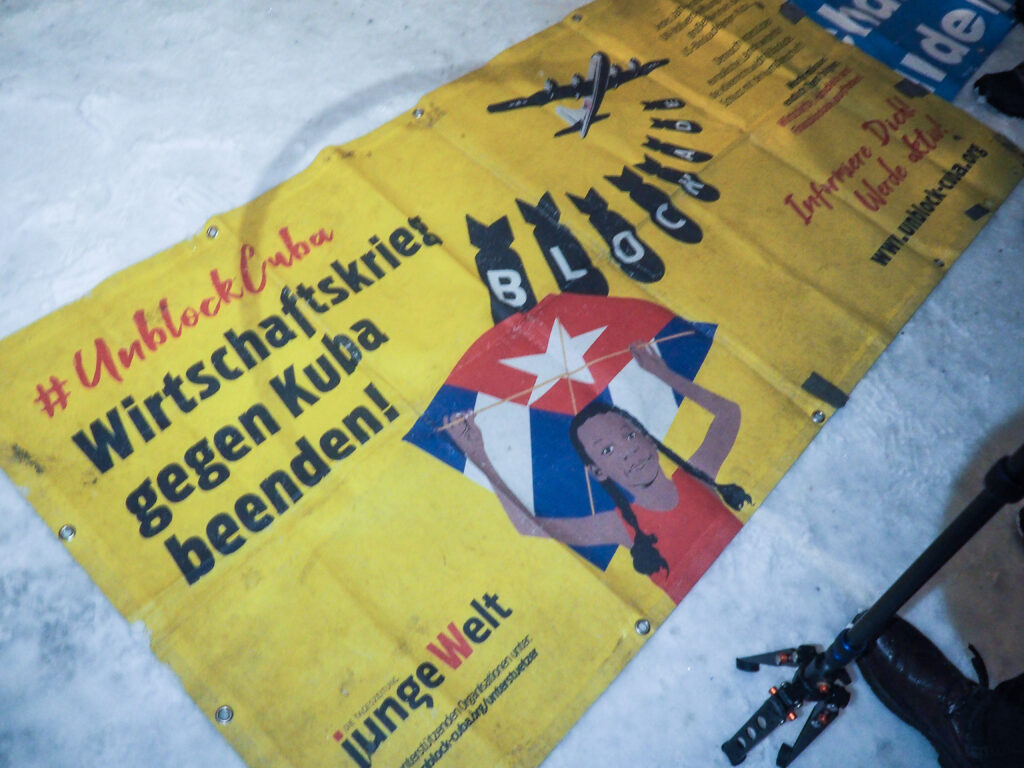



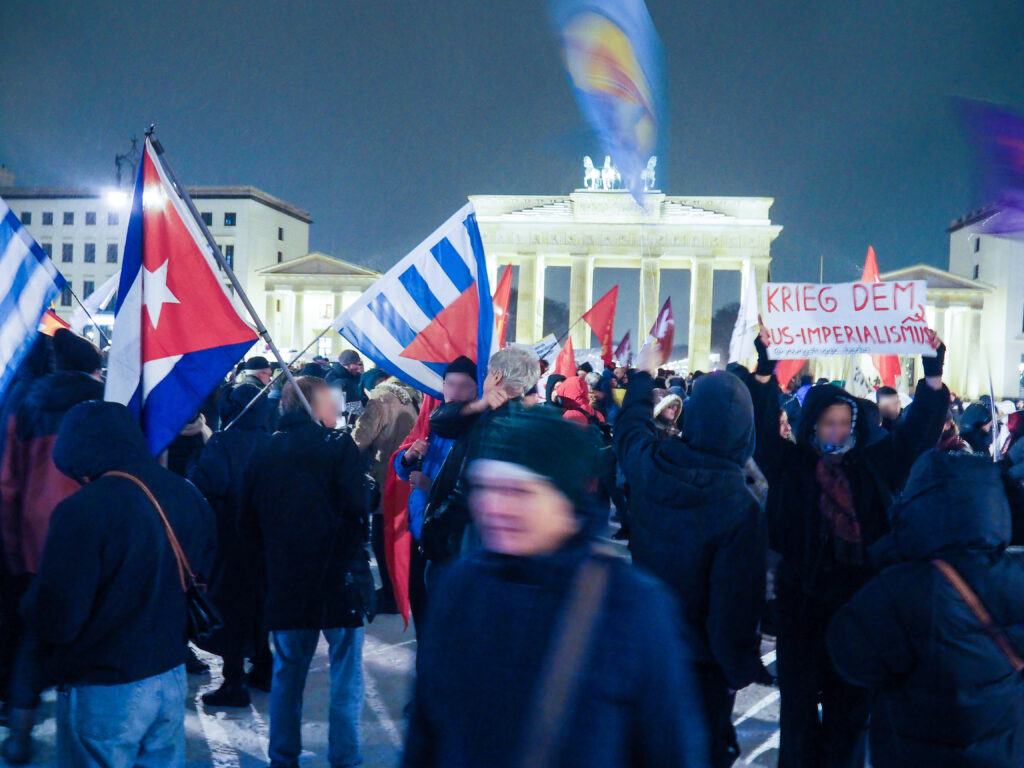






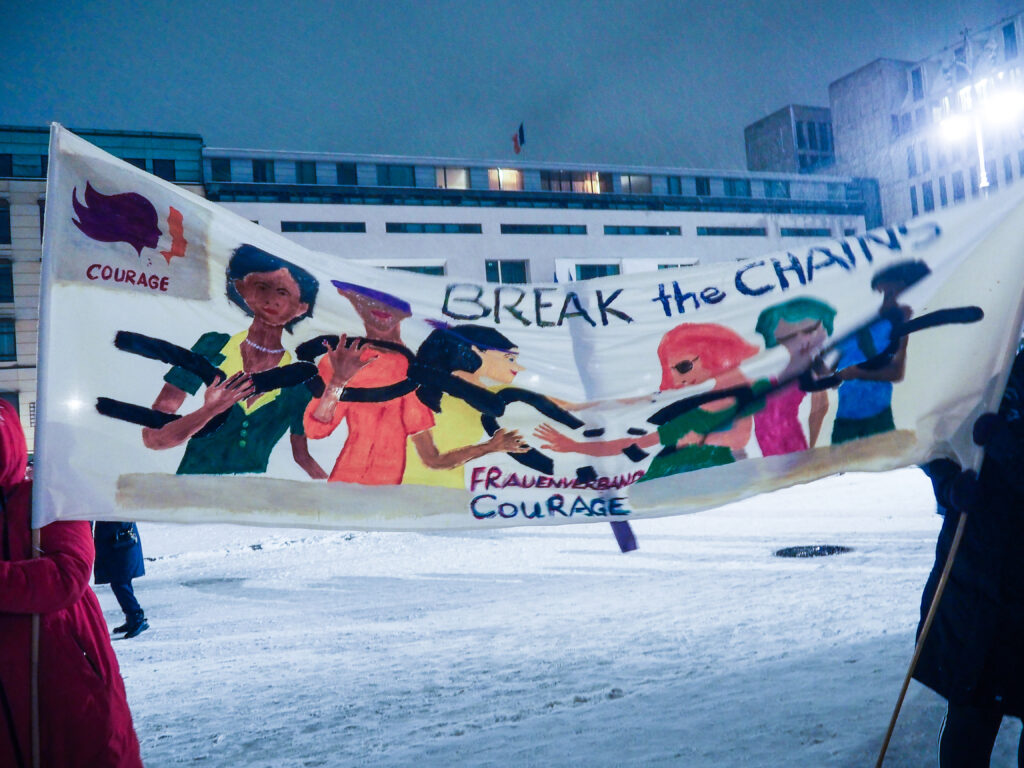


All photos: Dave Gilchrist
Outside the US Embassy, Brandenburger Tor
Dave Gilchrist
04/01/2026


























All photos: Dave Gilchrist
How EU supply chain protections were gutted by conservatives, corporations, and far-right alliances
Milla Mallikas
03/01/2026

The EU Supply Chain Law—already passed in 2024—was intended to oblige companies to respect human rights, the environment and climate protection in their global supply chains. However, in early December 2025, negotiators from the European Parliament and the Council of the 27 EU member states agreed on a version that effectively continues to exempt companies from any meangingful due diligence obligations. This followed a vote in November, when European conservatives, together with the far right, forced a new vote in Parliament with 382 votes to 249.
‘Despite the accusations, EPP group leader Manfred Weber expressed satisfaction with the outcome of the vote and spoke of a “good day for Europe’s competitiveness”,’ reported Tagesschau on 13 November.
The fight against windmills for more human rights and environmental protection
Dhaka, Bangladesh April 2013: 1,134 workers—most of them women—lost their lives and almost 2,500 were injured when the Rana Plaza garment factory collapsed. This disaster forced the media, trade unions, and political parties around the world to finally take a closer look at production conditions in international corporate supply chains. Workers of Rana Plaza, some of them minors, produced clothing for brands such as Benetton, C&A, KiK, and Zara for salaries of around €30–80 per month. Despite dangerous cracks being discovered in the building, factory owners coerced them into continuing work. Under pressure and without union organisation, the garment workers were compelled to enter the factory, only to be buried under the rubble a few hours later.
Capitalists typically relocate production further and further to so-called ‘poorer’ countries in order to exploit people and the environment through low wages and unhealthy—or even deadly—working conditions in the name of competitiveness. Violations of human rights, including modern slavery and child labour, are repeatedly justified by claims that global production chains are too complex and opaque to regulate. Local suppliers, in turn, argue that they cannot improve working conditions—particularly in the textile industry—because international corporations refuse to pay fair prices.
Workers and activists have always fought against this exploitation alongside demands for greater environment and climate protection. Eventually, the then German Federal Minister for Economic Cooperation and Development, Gerd Müller (CSU), attempted to draw concrete consequences for German corporations from the Rana Plaza disaster. He initially pursued voluntary due diligence commitments in supply chains—without success. He then drafted the mandatory German Supply Chain Due Diligence Act (LkSG) together with his SPD colleague Hubertus Heil. The attempt faced strong opposition from business associations such as BDI, BDA, DIHK, Gesamtmetal,l and Textil & Mode, as reported by taz. Despite obvious shortcomings—and criticism from civil society—the law was finally passed by the Bundestag in June 2021.
In May 2024, after a tough battle—including resistance from corporations such as France’s TotalEnergies, as Junge Welt reports—the EU Council, as the final authority, passed the EU Supply Chain Directive (Corporate Sustainability Due Diligence Directive – CSDDD). Although significantly watered down by compromise, it was intended to have a deeper impact on value chains than its German counterpart. Global Witness strongly critisised the law as too weak, but nevertheless considered it a milestone towards more binding corporate responsibility, moving away from hollow voluntary Corporate Social Responsibility (CSR) measures.
While other EU countries still have plenty of time to incorporate the new directive into their national laws, European Center for Constitutional and Human Rights (ECCHR) has been able to assess its German variant for two years. The study addresses vast shortcomings as well as violations, yet the law has enabled Ecuadorian and Costa Rican farmers to file complaints against German supermarket chains such as Aldi and Lidl.
Against slavery, child labour, exploitation, and environmental pollution—and with civil liability and clear sanctions—things appeared, after years of civil society pressure, to finally be moving in the right direction for global protection of workers, the environment, and the climate:
“This law is a historic breakthrough. Companies are now responsible for potential abuses in their value chain, ten years after the Rana Plaza tragedy. Let this deal be a tribute to the victims of that disaster, and a starting point for shaping the economy of the future – one that puts the well-being of people and the planet before profits and short-termism,” EU Parliament quoted lead MEP Lara Wolters (S&D, NL) in their press release 2023.
If only there were no crisis of capitalism, no powerful industry lobby, no energy dependency, and no rightward shift across Europe.
Together with the far right for more ‘competitiveness’: the thorn in capitalism’s side must be removed
Having only come into force in January 2023—and even having been drafted by party colleagues—the new black-red government is now abolishing the German LkSG, derided as a “great bureaucratic monster”, in its coalition agreement. In May 2025, the newly elected Chancellor Merz traveled to Brussels and, under the guise of “bureaucracy reduction”, called for the complete abolition of the new EU supply chain directive as well. This move surprised even his coalition partners and drew criticism from both the EU and the SPD, which had considered the German law one of its major achievements under Chancellor Angela Merkel. The SPD had agreed to a compromise: the German version would be replaced with the EU directive. Prior to this, business associations had already complained to then chancellor Olaf Scholz about the stagnating German economy, further undermining the LkSG.
Meanwhile, conservatives and liberals worked hard to significantly weaken the EU supply chain law, with Germany in particular opposing it. Resistance to the original version of the directive also came from abroad: Qatar threatened to cancel LNG exports for 2026 due to the “excessive requirements” of the planned due diligence obligations as Reuters reported. Moreover, according to new revelations available to SOMO, US energy companies such as ExxonMobil and Chevron also lobbied heavily, participating in a so-called “Competitiveness Roundtable” on the Omnibus I package to weaken the rules.
Human Rights Watch criticised the flawed and opaque process, in which no civil society actors were involved: “The process began on November 8, 2024, when EU Commission President Ursula von der Leyen announced a fleet of so-called Omnibus laws to simplify the European Green Deal. The proposed changes, made public only in February 2025, weakened key provisions of the corporate accountability law, making it harder for victims of rights abuses to sue companies.”
All political groups in the European Parliament had until November 2025 to submit amendments. The conservative European People’s Party (EPP), Social Democrats (S&D), and Liberals generally work together in an informal coalition within the EU. This time, however, some Social Democrat MEPs voted against the plan to significantly weaken the law in a secret ballot. Nonetheless, the conservatives still had an ace up their sleeve for a majority in Parliament: the right-wing and far-right parties, which are now well represented in the EU. In the end, with the votes of the right wing, the conservatives succeeded in watering down the EU Supply Chain Directive beyond recognition. According to estimates, the new law will only affect 15% of the companies originally planned: only 1,500 of the largest corporations with an annual turnover of €1.5 billion, down from millions initially envisaged. TCivil liability for human rights violations and the obligation to comply with the Paris Climate Agreement were also dropped.
“It repeats at European level what we experienced in Germany earlier this year: Contrary to repeated affirmations and without necessity, the CDU and CSU have entered into an alliance with the right-wing extremists and have finally brought down the firewall to the far right. Driven by the far-right, the Union is sacrificing key achievements for the global protection of human rights,” FEMNET states in their press release in November.
Only the workers rising up against global exploitation is the real solution!
This case shows how even well-intentioned reforms are systematically fought, diluted, and reversed by capital and those in power. Reforms can easily be undone by subsequent governments, especially during the ongoing crisis of capitalism that has persisted since at least the 2008 financial crash. Conservative forces no longer shy away from cooperation with the far right and fascists to impose corporate interests against workers, the environment, and the climate.
Although Bangladesh has now ratified all International Labour Organization (ILO) conventions and the number of trade unions has increased since the Rana Plaza catastrophe, worker organisation remains weak. In 2024, around 70% of the country’s 4,000 textile factories still had no registered trade unions, as reported by the Business and Human Rights Centre. Wages have risen only marginally, while workers in unsafe factories continue to fear for their lives. Survivors and relatives of Rana Plaza victims are still waiting in vain for accountability and adequate compensation.
Only when workers organise and rise up together internationally against capitalist corporations and factory owners—taking democratic control over how production is organised—will people, the environment, and the climate be genuinely and sustainably protected.
I’ve been writing reviews of the films of the year for several years now (you can read my reviews for 2018, 2019, 2020, 2021, 2022, 2023, and 2024 on my film blog). Here are my 20 favourite films of the past year (normal rules apply—all were released recently and I first saw them in the year 2025).
Remarkable documentary about the decolonisation of Africa, militant music, and the Black Power movement in the USA. Soundtrack to a Coup d’Ètat tells us what happened when, and why the half-hearted departure of Western powers led to their ongoing dominance of the Global South. It manages all this in a mood which is neither sombre nor hectoring. The film takes on the syncopated rhythms of the jazz music which features prominently. A revolutionary film in both form and content.
The year’s best ghost-music-romance-history-gangster-race-vampire film. Sinners tells many stories simultaneously, but it’s at its strongest when telling the Black experience in early Twentieth Century US America. One of those rare films in which the soundtrack is not just a set of cool songs which the director got the rights for, but an intrinsic part of the plot. I didn’t get on with director Ryan Coogler’s Black Panther, which makes it all the more reassuring that Sinners is both artistically and politically sensational.
Many of his best fans will acknowledge, firstly, that Paul Thomas Anderson’s films are of differing quality, and secondly, that he has tended to stay away from politics. So the idea of him as director of a counter-cultural, anti-capitalist fable did not inspire. But what can I say? Anderson is sensational, Leonardo di Caprio is sensational (but not as sensational as any number of the superlative supporting actors). Funny, politically astute, with a highly memorable car chase towards the end. And it all ends on a note of optimism.
There have been a heap of female-directed, socially conscious horror films lately, of which this is one of the best. Ostensibly a retelling of the Cinderella story from the point of view of her stepsisters, this takes on beauty myths and the extent to which women, and their mothers, will go in order to remain within accepted norms. And just in case that sounds too worthy, it is also hilarious. By the end, the film has also subverted the myth that any normal young woman’s ambition would seriously be to marry a prince, charming or otherwise.
My favourite German film of the year, is a low-budget film about troubled young women in care. Which (we’re seeing a trend here for the films I really liked this year) is also very funny. There are more laughs than in any other film you’ve seen which contains suicide attempts, trauma, and existential angst. This is a female-led film about the joy and pain of being young and irresponsible. Look out for first-time director Stella Marie Markert, and all the actors, but especially Zoe Stein, who plays the largely mute Malou.
A simple enough concept—a day in the life of an overworked nurse, where missing staff members is part of the usual routine. Leonie Benesch, who’s in everything nowadays, is typically efficient, but here she’s even better than usual in a film which shows the struggles of an individual nurse at the same time as making it clear that the problem is systemic. Relatives are (justifiably) frustrated and the private patient is typically entitled, but Heldin never descends into cliché. Instead, it’s an effective intervention in an ongoing debate.
There is one look from Stellan Skarsgård in the trailer which assures you that this is going to be good. Skarsgård plays an arrogant film maker who is aware of his greatness even though no-one goes to see his films any more. But one word from his daughter Nora criticising his parenting provokes a look of absolute disdain. Skarsgård is only the second best actor in this film about absent fathers and broken families. Renate Reinsve who plays Nora is even better. This is a grown-up film which is never too pompous.
Epic film which is officially from 9 different countries, but that’s only because of the ongoing occupation of Palestine. Cherien Dabis, who also plays the mother, tells the story of one Palestinian family from the Nakba till the present day. Several good documentaries about Palestine have been released in recent years, but few dramas, particularly one as comprehensive as this one (and for once, comprehensive here is not a synonym for “too long”). Tragic and highly informative about why Palestinians resist.
From the sublime to the supremely silly. Hundreds of Beavers is basically a cartoon starring real life actors, some of whom are in animal costumes. Trapper John Kayak is trapped in a cycle of killing beavers to trade for produce, in particular a gun with which he can kill beavers. The scale of the story gets larger and increasingly ridiculous. Anyone who goes to see Hundreds of Beavers and hates it has my full understanding, but if you’re prepared to go with it and accept the silliness, it can be uproarious fun.
Who’d have predicted that 2025 would be Kneecap’s year? (before they got slightly overtaken by Bob Vylan). This film, released at the beginning of the year, helped to bring many of us on-message. Ostensibly an “origins” film, whose biggest draw was a cameo by Michael Fassbender, this turned out to be a heap of fun with a decent soundtrack. The politics are a bit splattergun, if generally on the right side. It’s everything you’d expect from a band, two-thirds of whom were in their twenties (and looked even younger).
What is it about Winnipeg which produces such weird films? (I give you everything which Guy Maddin produced, especially My Winnipeg). This film is very much in Maddin’s tradition. Some reviewers tried to read too much into Universal Language, and in doing so removed most of its fun. This is a simple story about a search for some glasses, the retrieval of a 500 Rial note, and the tourist guide who has the least to show, all told in English, French, and Farsi. Don’t try and understand it, just sit back and enjoy the fun.
Post-First World War Poland was grim, if this story of evictions, disfigurement, and attempted abortion is anything to go by. There are few jokes and the film is shot in a menacing monochrome but it is a captivating story about the desperate lives of working class women. Seen in the wrong mood, this could be seen as arduous misery porn, but we do feel for the main characters and share their pain. Behind all the degradation, it’s a compelling story of surviving the worst misfortunes. May not be a great date movie.
A quirky story about a young woman who has not quite got the hang of adulting, especially after her best friend leaves for New York. All while she is struggling to cope with a Bad Thing. Extremely well-orchestrated mixture of youthful silliness and Serious Issues, this film could have quite easily been too exploitative, the camera could have lingered too long, or the tone could have just been too trivial to match the serious content. Instead it manages to be both fun and make very important points about women’s oppression.
50 years after Franco’s death, thousands of the people whose deaths he ordered still lie in unmarked graves. This film shows the opportunities opened up by Spain’s 1936 Popular Front government, but also the repression which followed. The history lesson is mixed with a contemporary story of one of the many families trying to locate its forebears. This is a film which could have very easily been worthy but dull, but the fighting spirit and thirst for more engages the audience. It’s a story which is still very relevant.
After Trainspotting became a phenomenon, and Danny Boyle was given increasingly large budgets, he didn’t always use them well. 28 Years Later combines Boyle’s Indie sensibility with some astounding set pieces. Throughout the film, we are unsettled by a sense of eerie unease, built on the wreckage of post-Brexit England. This is all leading up to a final 5 minutes in a quite different tone which ruined everything for some viewers. Then there are others, like me, who just can’t wait for the coming sequel.
Guillermo del Toro was never going to make an understated Ken Loach-like Frankenstein. This film stays largely to the book, much to the disappointment of fans of neck bolts. We are shown a tale of hubris, told from the perspective of both an enlightenment scientist and his creation. There are plenty of metaphors hanging down for anyone who chooses to make something of them—about loneliness, the dangers of unfettered science, and of men being men. But the film also works as a spectacular action-packed yarn.
What initially looks like a superficial comedy about a neurotic Jew from New York, actually contains more depth than you’d first think. The withdrawn David and his brash cousin Benji are on a heritage tour of Poland, trying to find out what happened to their dead relatives who died in the Holocaust. The film manages to address the immensity of what happened without falling into trite sentimentality. And, however superficial Benji first appears to be, it is he who possesses the film’s heart and soul.
If you read a description of Companion, it feels like it’s going to be one of those single-concept Science Fiction Issue Movies, which is worth a single viewing but has little new to tell us. And yes, it is about consumerism, gender role expectations, and the commodification of love. But then it gets batshit crazy and a load more fun. Come for the comfortable feeling that the film is on the right side politically. Stay for some astute political analysis, over-the-top mayhem, and jokes which are way too funny for this sort of film.
A new Andrea Arnold film is always to be welcomed, even the ones which are not an easy watch. You can be sure from the start that this is not going to be set in some Gosford Park / Friends, alternative yuppie universe. Bird is a story with parallel plots, some of which are more effective than others. It stars Franz Rogowski and Barry Keoghan, neither of whom is ever uninteresting. They are more than matched by Nykiya Adams as the mixed-race hero Bailey, trying to negotiate a difficult world despite her irresponsible father.
Bruce Springsteen’s mental breakdown: the movie. A film about the making of Nebraska—one of Springsteen’s least successful (and best) albums, was always going to be polarising, but I never expected it to be so introspective. This is the anti-Bohemian Rhapsody / Rocket Man (which is meant in a good way). None of the bombast of most recent biopics, and an honest account of the artistic process when things are not going well. Not at all what I was expecting—a very nuanced film which has something to say.
And here are my 5 least favourite films of the year:
5. The End
The End found its way onto some critics’ Best-Of lists, and to be fair, it is not an offensive film, just very, very boring. It’s a post-apocalyptic world, and a couple is living with their servants and son in a bunker full of paintings which were once extremely expensive (some Important Points are obviously being made). And then, for no obvious reason, everyone starts singing. This is an overlong musical whose characters show no emotion, and even the songs are uninspiring. Tilda Swinton, you are so much better than this.
4. Parthenope
Parthenope is beautiful and intelligent. Of course she is. This is not the sort of film which is interested in the ugly, little people. She spends most of her time hanging around the beach in a bikini and doing her best to hide the intelligence which other characters assure us that she has. Everybody but a hammy Gary Oldman is in awe of Parthenope’s captivating beauty. The film, made in collaboration with Yves Saint Laurent, is little more than an extended advert. Like Parthenope, it is very pretty but has nothing to say.
The Helsinki Effect is not a bad film as such. It presents a case, which it backs up with documentary footage. But its main argument is based on such flimsy logic that it just does not work. Apparently, a 1975 meeting in FInland between Western and Soviet Bloc countries indirectly led to the downfall of the USSR. Except that there is no convincing argument that this is what happened. The real time coverage of boring meetings, the adulation of “Western democracy,” and Henry Kissinger. Nothing in this film is remotely credible.
2. Loyal Friend
Never work with animals or late period Bill Murray. Loyal Friend is a sentimental mush fest about a woman inheriting her late friend’s dog. She hates the dog at first (but still accepts it for no obvious reason), but can you guess if she gets to love it by the end of the film? This is a film about the obnoxiously wealthy whose arrogant behaviour we are expected to admire. It states that its characters are intelligent without any of them saying anything of any intelligence. It is not just predictable. It is dull.
I saw a number of films in 2025 which were a waste of my time. After the Hunt was the only one which truly offended me. It is Luca Guadagnino’s take on #MeToo. And guess what? Guadagnino has nothing of interest to say of the systematic exclusion of women from academia. At best he’s saying “it’s complicated,” at worst it’s the women’s fault. This is the sort of film which some critics will laud for being daring, when it has an implausible and clichéd plot which just parrots the prejudices of the right wing media.
Most read articles on theleftberlin.com in 2025
Phil Butland
01/01/2026

2025 started in the middle of an election campaign, after the SPD-Green-FDP coalition collapsed in November. The elections were held in February, and the big winners were the right wing, with Friedrich Merz’s CDU gaining 28.5% of the vote, and the AfD 20.5%. All the ruling parties saw their vote fall, some dramatically. In contrast, Die Linke got 8.7%, nearly 3 times as many as what they were polling at at the beginning of the campaign.
The CDU-SPD coalition immediately went into attack mode and tried to make us pay for Germany’s failing economy. Police violence against Palestine demonstrators in Berlin and throughout Germany reached a worrying level. By the end of the year, Germany was building its military and making the first steps towards compulsory military service—steps which were resisted by a growing youth movement.
The increasing Nazification of the AfD, combined with its growing electoral support, led to a number of large demonstrations—against its party conference in Riesa in January, in Berlin in February, and against the formation of their street fighting youth organisation in Gießen in November. We will need to build more of these demonstrations in 2026.
As Israel continues to bomb Gaza (despite a so-called “ceasefire,” the world, and even Germany, saw mass actions for Palestine in front of the Bundestag in February, on Nakba Day in May, in Berlin in June with 60,000 demonstrators, and many more. 27th September saw Germany’s largest ever demonstration for Palestine, with between 100,000 and 150,000 taking to the streets.
Berlin saw a whole number of other internationalist demonstrations, including those for Congo in February and March, on International Women’s Day in March, for the Philippines and at Internationalist Queer Pride in July, and against Donald Trump’s attacks on Latin America in December.
We tried to cover all of this in our website and Newsletter, in which we introduced a new feature (“This week in working class history”). The list below tells you which articles you, our readers, read the most. It follows similar reports about 2022, 2023, and 2024. The statistics show an increasing number of people both reading and writing the articles. The 30 articles with 1,000 readers or more were written by 24 different authors.
We would like to encourage you to be a more active part of creating our website and Newsletter. In particular, we invite you to a face-to-face open meeting of our editorial board on 17th January, and our Fourth Left Journalism Day School on 21st February in Theater X. If you want to know more, you can contact us at team@theleftberlin.com. And if you are not already one of our 3,908 subscribers, you can subscribe to our Newsletter now.
Our most viewed article of 2025 was first published in November 2024. Following 2 articles of pen portraits of the radical activists and artists buried in Berlin’s cemeteries, Phil Butland wrote a longer biography of solo artist and occasional Velvet Underground singer Nico. The article covers Nico’s radical music, together with her less savoury politics, including racism, nationalism, and internalised misogyny.
Excerpt: “Good politics can inspire good music, but there is no direct relationship between the two. Wagner was a great composer and an antisemite, Ezra Pound a great poet and a Fascist. David Bowie produced some of his greatest works when he was calling for a new Hitler and raping underage girls.”
Also written in November 2024 (and our fourth most read article last year), this analysis by the Antifascist Music Alliance, which was updated in January, continued to find an audience. It looks at Berghain’s active role in the suppression of pro-Palestine acts and the boycott organised by Ravers for Palestine. Antifascist Music Alliance interviewed the artists supporting the boycott and called for bigger names to do the same.
Excerpt: “As we’ve seen in other solidarity efforts, it’s those with the least wealth, structural privilege and access that are standing with Palestine. It’s not a coincidence that these are generally also the artists that are pushing techno and other forms into the future.”
In February, as pro-Israel bars in Berlin launched a campaign against so-called “threats, violence, and boycott,” Nathaniel Flakin interviewed Jewish activist Yuval Carasso who had attended a meeting about antisemitism in Bajszel bar and been violently ejected from the event for being the “wrong sort of Jew.” Carasso was then arrested, but the case by the police was thrown out of court.
Excerpt: “when the audience had the chance to ask questions, Udi Raz asked if there were any Jewish people present. She was the only person who raised her hand. The only other Jews in the room were me, who had already been kicked out.”
In October, as Europe prepared for war and Germany introduced the first stages towards conscription, Helfenstein looked at the drive to militarisation. Helfenstein argued that violence is being normalised as a way of encouraging us to accept wars in the (potentially) near future. The German Zeitenwende is an important part of this, especially in Germany whose history has encouraged a feeling of pacifism.
Excerpt: “War is not just a single event to prepare for, it is an ongoing situation that requires the cooperation of a whole society. For war to happen, people must be ready to fight, while others must cheer for the soldiers—or at the very least look away. It requires a profound change in culture.”
In another old article (and 9th most read last year), Weissmann’s dissection of Sascha Lobo from April 2024 remains relevant as Lobo plays the role of Zionism’s clown prince in the German media. Lobo demanded dismantling UNRWA, which he claimed had overlapping interest with Hamas. Unsurprisingly, if depressingly, Lobo still has a column in Der Spiegel and is a sought-after public speaker.
Excerpt: “The assumption that Jews can only be safe in an ethnostate that metes out violence onto others is an implicit and, from Lobo’s worldview where Israel is the eternal victim, paradoxical admission that Jews can only be safe if they become perpetrators of mass violence themselves.”
In an article from May 2024, which is as relevant as ever, White looked at the AfD’s links with Israel. Although the party is riddled with antisemites, its Islamophobia and anti-migrant rhetoric has led it to find common cause with the apartheid State. Isobel goes on to argue that the AfD’s Nazi links and derision for Holocaust victims means that it can offer no protection for Jewish people, whatever it says about Israel.
Excerpt: “A party that will so readily turn human lives into political pawns, atrocities into justification for bigotry, is a true danger to society, both in Germany and abroad. It is further proof that the AfD’s only real political convictions are fear-mongering and xenophobic hatred.”
Another old article by the Antifascist Music Alliance, this time from June 2023. This article shows that despite its clampdown on pro-Palestine artists (see above), Berghain, and its label Ostgut were much more indulgent of neo-Nazi Dominick Fernow and his KKK-supporting band Genocide Organ. When confronted about this, Berghain, Resident Advisor, and Pitchfork all refused to respond.
Excerpt: “Genocide Organ has released KKK and neo-nazi music, like their 1998 album Klan Kountry, with cover art featuring a Confederate flag. Some song titles from other albums include White Power Forces, Woman Is Meat, and John Birch Society, referencing a far-right extremist group in the US.”
Published in December 2024, as the election campaign was kicking off, Rowan Gaudet looked through the CDU/CSU’s manifesto. Rowan looked at CDU leader (and current Chancellor) Friedrich Merz’s sexist record, and correctly predicted a government of austerity, militarisation, and cuts in social services, including attacks on the unemployed and tax benefits for landlords and the rich.
Excerpt: ”any CDU-led government will need to be widely opposed … As crucial is opposing the austerity measures which would strip safe housing and continue to slowly destroy Germany’s hospitals and Kitas, not to mention reduced building regulations putting families at risk for generations to come.”
In one of last year’s best books, Mohammed El-Kurd explained how and why the Western media dehumanise all Palestinians—including supporters of Hamas. He argued that all Palestinians should be heard, that the media must explain and understand Palestinians who feel provoked into violent reaction, and not just those which the West have deemed to be “good.” We reviewed Mohammed’s book in March.
Excerpt: “Why is it that Palestinians are expected to constantly temper their grief and rage toward them, as they collect their loved ones’ limbs in bags? Does it change the quality of Israeli atrocities against them? Or in other words, must victims be ‘good’ and possess all the ‘right’ views to deserve human rights, to deserve life?”
In March and April, Jason Oberman published 3 articles about Germany’s legal apparatus. The first article was the most popular. It explains Volksverhetzung, a hate speech law often used by the Berlin police. Jason looked at the history of the Volksverhetzung, and argued that, although it has always been used as an instrument of repression, its use against pro-Palestine protestors have reached a new level.
Excerpt: “As antisemitism has been redefined to mean Palestinian people, Muslims, leftist Jews and critics of state violence and genocide, one must wonder how far we have come from Germany’s darkest years. As we keep exploring the history of this law, we must realize with heavy hearts, we have not come very far at all.”
#11 Wolt Claims to be Apolitical but its Actions Suggest Otherwise, The Left Berlin (1,918 views)
#12 When British pubs said “Black Troops Only”, Judy Cox (1,906 views). First published: July 2022 (#22 last year)
#13 What is the point of German Memory Culture when it has no universal application?, Phil Butland (1,855 views). First published: May 2025
#14 Wartime Survival Guide, Ilya Kharkow (1,841 views). First published: July 2024
#15 “It’s Not About Us”, Phil Butland and Tigris Vici (1,759 views). First published: May 2025
#16 Ibrahim Traoré: A new dictator or true socialist revolutionary?, Milla Mallikas (1,647 views). First published: July 2025
#17 Is This Fascism? For Palestine, Yes, Wael Eskander (1,516 views). First published: May 2025
#18 Statement by The Left Berlin on Die Linke, The Left Berlin (1,510 views). First published: November 2024
#19 Yes, the German Democratic Republic was socialist—and we have much to learn from it, Internationale Forschungsstelle DDR (1,307 views). First published: September 2025
#20 Against the Weaponisation of Antisemitism to Impose Censorship in Education, The Left Berlin (1,224 views). First published: January 2025
#21 Opinion: I’m done with ‘statements’, JD Vans (1,181 views). First published: March 2025
#22 From the Bogside to Brexit—The Long Shadow of Bloody Sunday, The Left Berlin (1,180 views). First published: January 2022
#23 Red Flag: Your tax money for Israeli war propaganda, Nathaniel Flakin (1,179 views). First published: September 2025
#24 Germany vs. the Ulm 5, Roser Garí Pérez (1,150 views). First published: December 2025
#25 Divided solidarity: The two Pro-Gaza marches in Berlin and the question of unity, Rafael Sergi (1,129 views). First published: October 2025
#26 Queer festival ‘Whole’ and the political significance of clubbing, Rafael Sergi (1,111 views). First published: September 2024
#27 Red Flag: Watermelons at the Fusion Festival, Nathaniel Flakin (1,104 views). First published: July 2025
#28 The key to normalising fascism: selective solidarity, Boldizsar M. Nagy (1,047 views). First published: April 2025
#29 Riders without rights, TG Durutti (1,036 views). First published: July 2025
#30 Should We Boycott No Other Land?, Phil Butland (1,002 views). First published: March 2025
Racist instrumentalization of violence against women and actual pathways to Women’s security
Juliette C
30/12/2025

This year in Germany, at least 132 women and two girls were killed in femicides. While using women’s security to push its racist agenda, the CDU is only endangering women even more.
As the end of December approaches, and about one month after the International Day for the Elimination of Gender-based violence, it is time to look back at the situation for women in Germany this year. One thing has not changed compared to previous years: women are still killed for being women—this year, at least 134.
While the CDU claims to defend women’s rights, it simultaneously endangers women by cutting the very budgets meant to protect them and by instrumentalizing women’s rights to justify racist policies. Fighting femicide is only possible by increasing funding for women’s projects and finally paying women (fairly) for the (unpaid) work they do.
In Germany, there is no legal term for femicide. It is however described by the Istanbul Convention, signed by Germany in 2018, as the killing of a woman because of her gender. Under this definition, two different kinds of femicides are sometimes distinguished: when women are killed for a sexist motive—for example, because they do not follow typical gender roles—and when women are killed because their position in society makes them vulnerable to such killings—for example, because of their lack of financial independence or their care duties.
The definition of femicide is still broad and leads to different ways of counting femicides, as there are different ways of identifying the motivations behind the killings. The quickest way to shed light on femicide is to look at press reports and count the cases of women killed by someone they knew. This is what onebillionraising.de does, and this is where the number of 134 girls and women comes from.
Another way of getting statistics on femicides is to use criminal and police statistics. This allows access to more cases than press reports but has the drawback that the waiting time to get the data is a bit longer. In the “Femicide in Germany” report, the German Institute for Human Rights analyzed criminal and police statistics in order to quantify and analyze femicides in Germany.
What the authors find is that in 2024 in Germany, 824 women and girls were victims of attempted femicides. This means that in 2024, there were more than 2 attempts per day to kill a woman. 300 of these attempts were perpetrated by the victims’ partner or ex-partner. In Germany in 2024, almost every day a woman or a girl was the victim of a killing attempt by her partner or ex-partner. Moreover, 144 perpetrators were family members of the victims.
This means that more than 50% of attempted killings of women come from the close circle of the victim. By comparison, less than 15% of attempted killings of men were perpetrated by their (ex-)partner or family members. This indicates that the place where women are least safe is the private space and contradicts the racist uses of feminism by right-wing actors, who argue that the real threat to Western women comes from immigrants in public spaces. The most dangerous people for women are their (ex-)partners or family members. In Berlin, however, CDU mayor Kai Wegner decided to close the Görlitzer Park at night after an accusation of rape in the park. He did so while reducing the budget for women’s projects and spaces, spaces that are crucial in fighting femicides, as they offer an escape to the outside for women who are victims of violence in the private sphere. Moreover, in 2024, the CDU closed two girls’ projects in Berlin Kreuzberg-Friedrichshain because of the private engagement of some of its workers against the genocide in Palestine, a genocide in which thousands of women are killed with German weapons.
Indeed, a recent study on femicide in Germany shows that the lack of places in women’s shelters (buildings dedicated to women who are victims of domestic violence) is decisive in femicide: several cases analyzed occurred because of failed attempts to secure a place in a women’s shelter. According to German law, the country should have 21,000 places in women’s shelters to protect women against domestic violence, but it currently only has 7,000–8,000. Moreover, other spaces are crucial to protect women from domestic violence and femicides, such as cultural spaces or (legal) advice centers, as they allow women to maintain connections with the outside world while being at risk in the private sphere. Education and support programs for violent men are also needed, as well as educational programs for children, to combat sexist violence. By cutting the budget for women’s spaces—including shelters and associative projects that provide women with a connection to the outside—the CDU thus decides to endanger women and put them even more at risk, while using their security as a fake argument to pursue its racist agenda and criminalize people of color living in or spending time in Görlitzer Park at night.
At the national level, a new law introduced by the Greens and the SPD has been passed with the support of the CDU. It will provide more funding for women’s shelters and new rights for women who are victims of domestic violence. This, however, will only come into effect in… 2032. In the meantime, men continue to kill women: this year, at least 134.
Finally, women’s shelters and women’s projects won’t do the job alone: women will only be safe once they are financially independent from men. This is only possible by achieving economic equality between men and women. Currently, women are paid 16% less than men in Germany. This gap is even larger for women of color and does not take into account the reproductive work that women do for free. It also does not capture the full extent of economic inequality, as other factors play a role, such as the unequal distribution and taxation of money in heterosexual marriages. Providing fair wages for care and reproductive work, which is disproportionately performed by women, often migrant women and either unpaid or poorly paid, is one of the many necessary steps to achieve economic equality between men and women, and, with it, to protect women from violence by men This, however, is only possible by changing the structure of the capitalist system, which relies on the exploitation of women, and especially women of color, in order to persist.
We won’t achieve security for women by racist measures, and the CDU won’t defend our rights. Moreover, we want more than the weak law pushed by the SPD and the Greens. What we wish for in 2026 to fight femicide in Germany is therefore an immediate increase in the budget to protect women when they are at risk by creating more places in women’s shelters and financing women’s projects instead of cutting their budgets. But also, and perhaps even more importantly, we want women to finally get paid (fairly) for their work so that they are independent from the greatest danger they face: the men in their private spaces.